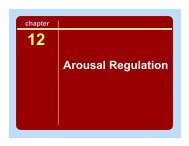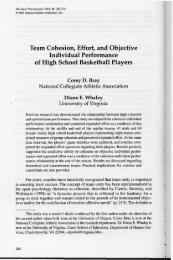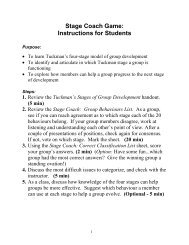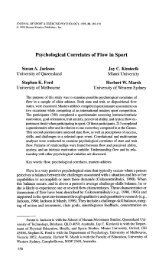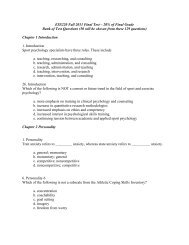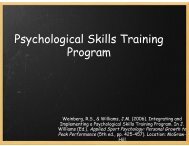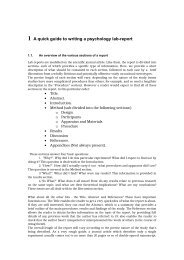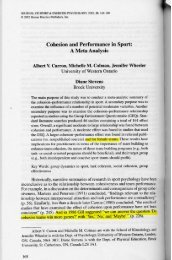The Development of Imagery in Dance
The Development of Imagery in Dance
The Development of Imagery in Dance
You also want an ePaper? Increase the reach of your titles
YUMPU automatically turns print PDFs into web optimized ePapers that Google loves.
22 Volume 10, NiimhcTs I 6" 2, 2006 • Journal <strong>of</strong> <strong>Dance</strong> Medic<strong>in</strong>e C^ Science<br />
<strong>in</strong>g repertoire <strong>of</strong> psychological skills<br />
than their national counterparts.<br />
However, the PST program helped<br />
the three national g)'mnasts acquire<br />
skills similar to those employed by the<br />
<strong>in</strong>ternational gymnasts. As a result,<br />
the quality and complexity <strong>of</strong> their<br />
imagery and other skills stu'passed<br />
those <strong>of</strong> the three national-level gymnasts<br />
who had nor received any formal<br />
tra<strong>in</strong><strong>in</strong>g.<br />
Research conducted thus far <strong>in</strong><br />
sptirts seetiis to suggest that the acquisition<br />
<strong>of</strong> imagery skills by athletes<br />
usually occurs gradually, via different<br />
sources, and <strong>of</strong>ten <strong>in</strong>direct methods.<br />
Structured imagery tra<strong>in</strong><strong>in</strong>g programs<br />
can improve this process*^ " but are<br />
not the usual means by which athletes<br />
learn about imagery. By comparison,<br />
available sttidies suggest that dancers<br />
may learn about imagery <strong>in</strong> a slightly<br />
more direct manner. For <strong>in</strong>stance, a<br />
comparison ot the imagery <strong>in</strong>structional<br />
methods used by three groups<br />
<strong>of</strong> <strong>in</strong>structors found that dance<br />
teachers and figure skat<strong>in</strong>g coaches<br />
encouraged their performers to use<br />
imagery more than did soccer coaches<br />
before and dur<strong>in</strong>g practices, as well as<br />
before performances.''<strong>The</strong> similarities<br />
between the dance <strong>in</strong>structors and figure<br />
skat<strong>in</strong>g coaches are not altogether<br />
surpris<strong>in</strong>g given the artistic nature<br />
that is <strong>in</strong>herent to both activities. It<br />
should be noted that when Overby<br />
and colleagues described encouragement<br />
to use imagery, they were<br />
referr<strong>in</strong>g to concrete types <strong>of</strong> images,<br />
such as rehears<strong>in</strong>g skills and sequences<br />
<strong>in</strong> one's head.'' However, they also<br />
<strong>in</strong>vestigated the <strong>in</strong>structors' use <strong>of</strong><br />
metaphorical images. Tliese are more<br />
abstract, <strong>of</strong>ten referr<strong>in</strong>g to actions<br />
and sensations that may not be objectively<br />
possible, for example "mov<strong>in</strong>g<br />
across the floor as if mov<strong>in</strong>g through<br />
water,"'- or "walk<strong>in</strong>g and turn<strong>in</strong>g as<br />
if there were no gravity to keep yoti<br />
earthbound."'' It has previously been<br />
found that dance teachers frequently<br />
give out such metaphorical images<br />
<strong>in</strong> classes as <strong>in</strong>structional cues or as<br />
<strong>in</strong>spiration for their sttidents." To<br />
return to the direct comparison study<br />
done by Overby and colleagties, It was<br />
found that dance teachers used more<br />
metaphorical imagery than either<br />
figure skat<strong>in</strong>g or soccer coaches.''This<br />
is an <strong>in</strong>terest<strong>in</strong>g f<strong>in</strong>d<strong>in</strong>g because such<br />
images have been shown to improve<br />
performance, both for children and<br />
for student dancers.'* "' Yet, apart<br />
from the work done by Overby and<br />
colleagues, all <strong>of</strong> the aforementioned<br />
studies concern<strong>in</strong>g imagery development<br />
have focused solely on concrete<br />
types <strong>of</strong> imagery, to the exclusion <strong>of</strong><br />
metaphorical imagery types."'"''^<br />
A third and f<strong>in</strong>al po<strong>in</strong>t to note from<br />
the restilts <strong>of</strong> Overby and colleagues<br />
was that none <strong>of</strong> the three groups <strong>of</strong><br />
<strong>in</strong>strtictors (dance teachers, figure<br />
skat<strong>in</strong>g coaches, or soccer coaches) reported<br />
us<strong>in</strong>g imagery <strong>in</strong> an organized<br />
way.'- lliis is noteworthy because it<br />
has been suggested that imagery use<br />
shotild be structured and regular for<br />
best effect.' Gould, Damarjian, and<br />
Medbery reported similarly unsystematic<br />
<strong>in</strong>corporation <strong>of</strong> mental skills <strong>in</strong>to<br />
junior tennis coach<strong>in</strong>g, despite more<br />
than half <strong>of</strong> their sample consist<strong>in</strong>g <strong>of</strong><br />
coaches with some sports psychology<br />
tra<strong>in</strong><strong>in</strong>g.'" More encourag<strong>in</strong>gly. Hall<br />
and Rodgers found that follow<strong>in</strong>g a<br />
mental skills tra<strong>in</strong><strong>in</strong>g program with<br />
figure skat<strong>in</strong>g coaches, the athletes<br />
coached by the participants reported<br />
that their lessons had improved.''<br />
Given these f<strong>in</strong>d<strong>in</strong>gs and the<br />
general lack <strong>of</strong> research <strong>in</strong>to imagery<br />
development, two studies were undertaken.<br />
'Ihc broad aims <strong>of</strong> these studies<br />
were to enhance our understand<strong>in</strong>g<br />
<strong>of</strong> how imagery develops <strong>in</strong> dancers,<br />
and to <strong>in</strong>vestigate the role <strong>of</strong> the dance<br />
teacher for a dancer's imagery development.<br />
Because the area is relatively<br />
under-<strong>in</strong>vestigated, qualitative methods<br />
were deemed suitable as a first step<br />
to explore imagery development <strong>in</strong><br />
depth. Elite performers were chosen<br />
to participate <strong>in</strong> Part I because they<br />
are likely to have superior experience<br />
and knowledge <strong>of</strong> imagery compared<br />
to lower-level performers."^" As part<br />
<strong>of</strong> a larger qualitative study perta<strong>in</strong><strong>in</strong>g<br />
to dance imagery, we employed a<br />
sample <strong>of</strong> 14 pr<strong>of</strong>essional dancers. "Ihe<br />
<strong>in</strong>terview results perta<strong>in</strong><strong>in</strong>g to imagery<br />
development are thus reported <strong>in</strong> the<br />
present paper (Part I). To complement<br />
these f<strong>in</strong>d<strong>in</strong>gs with more generalized<br />
data, a second study was conducted.<br />
That study built on the f<strong>in</strong>d<strong>in</strong>gs <strong>of</strong><br />
Part 1 by us<strong>in</strong>g a quantitative methodology<br />
to <strong>in</strong>vestigate imagery development<br />
with a large, heterogeneous<br />
sample, and the results <strong>of</strong> that study<br />
arc presented <strong>in</strong> a separate paper (Part<br />
H).<br />
In sum, the aims <strong>of</strong> the present<br />
<strong>in</strong>vestigation were to ga<strong>in</strong> an understand<strong>in</strong>g<br />
<strong>of</strong> how imagery develops <strong>in</strong><br />
dance sett<strong>in</strong>gs, and to explore the role<br />
<strong>of</strong> dance teachers <strong>in</strong> imagery development.<br />
In the study presented here,<br />
semi-structured qualitative <strong>in</strong>terviews<br />
were conducted to get a first, exploratory<br />
<strong>in</strong>sight <strong>in</strong>to the topic.<br />
Method<br />
Participants<br />
Fourteen pr<strong>of</strong>essiotial dancers were<br />
recruited to participate <strong>in</strong> this study.<br />
N<strong>in</strong>e were female and five were male,<br />
and their ages ranged from 22 to 42<br />
(M - 30.00, SD - 6.71). Six dancers<br />
worked <strong>in</strong> classical ballet, one <strong>in</strong><br />
Kathak, and six <strong>in</strong> various types <strong>of</strong><br />
contemporary dance. One participant<br />
no longer described herself as a<br />
dancer but as someone who <strong>in</strong>tegrates<br />
live art, performance and video with<br />
contemporary dance <strong>in</strong> her work. 'Ihe<br />
sample had participated <strong>in</strong> dance for<br />
21.85 years (SD - 5.64) and they had<br />
been pr<strong>of</strong>essionals for 7.61 years (SD<br />
= 4.63). <strong>The</strong>y first took up dance at<br />
7.64 years <strong>of</strong> age (SD - 5.47).<br />
Materials<br />
Questions concern<strong>in</strong>g imagery development<br />
were constructed for an <strong>in</strong>terview<br />
guide based on the exist<strong>in</strong>g relevant<br />
literature <strong>in</strong> dance and sports psychology.'*'''""<br />
Ihese questions concerned<br />
the reasons why the dancers first began<br />
us<strong>in</strong>g imagery, whether they started to<br />
do so nattirally or were explicitly taught,<br />
and how their imagery skills had developed<br />
across their careers. <strong>The</strong> role <strong>of</strong> the<br />
teacher, both when the dancers were<br />
younger and at the present time, was<br />
also explored. Ihese questions concerned<br />
whether teachers gave out images <strong>in</strong><br />
class, and whether teachers encouraged<br />
the dancers to image on their own. Ilie<br />
use <strong>of</strong> an <strong>in</strong>terview guide ensured that<br />
the same open-ended ma<strong>in</strong> questions



